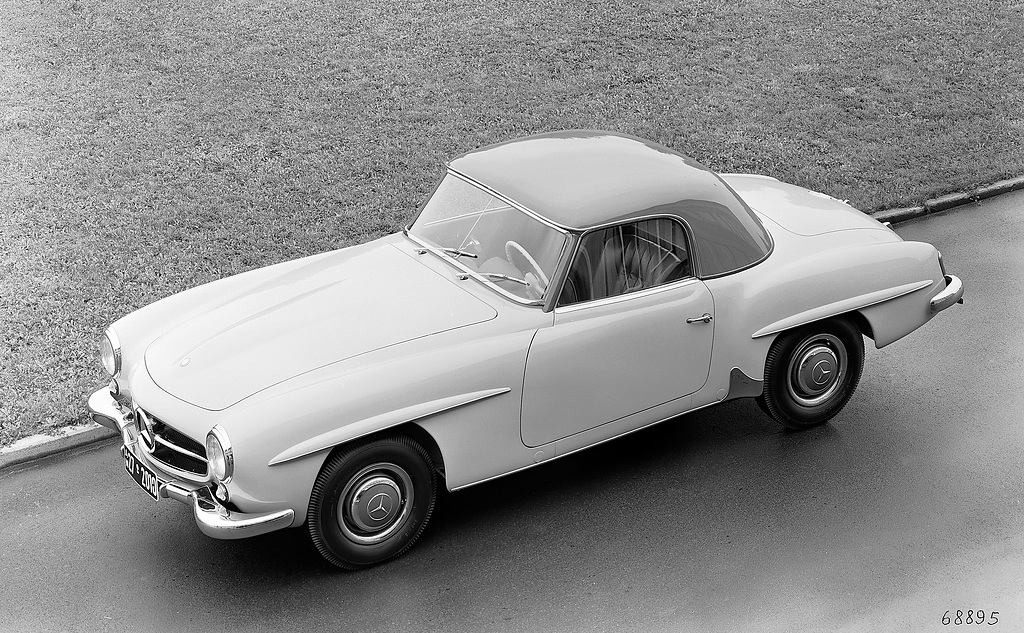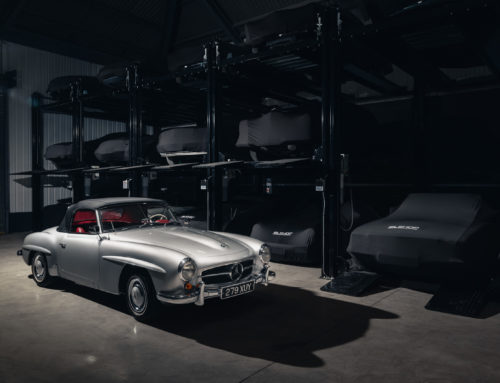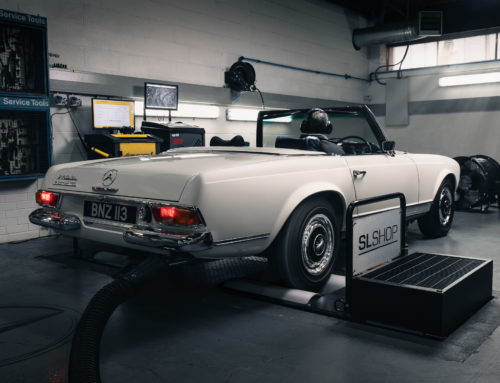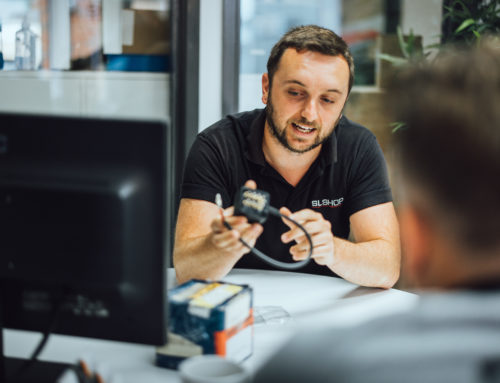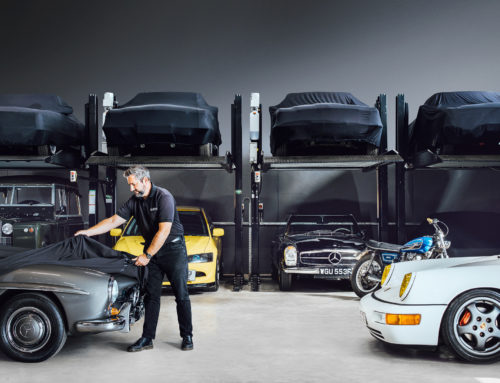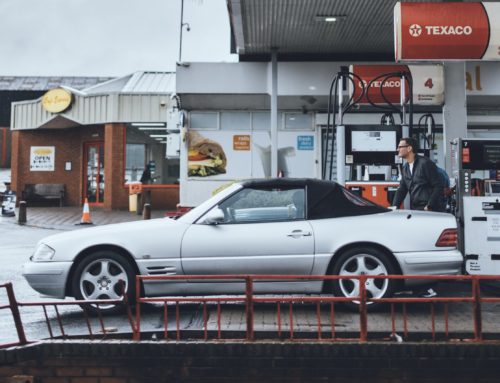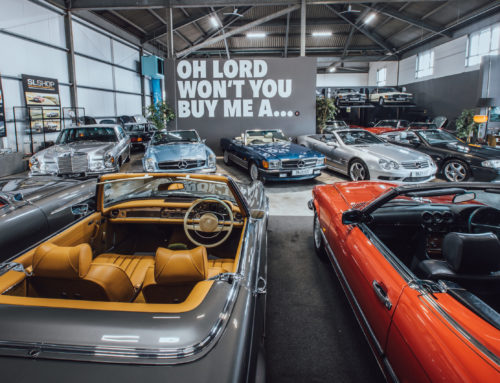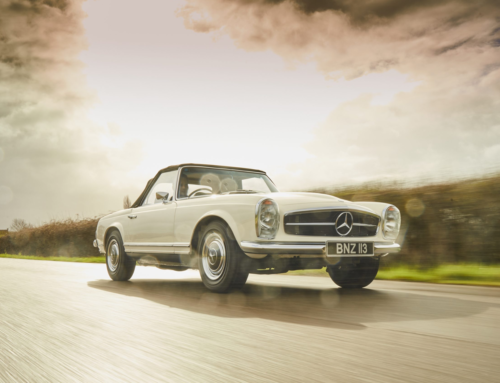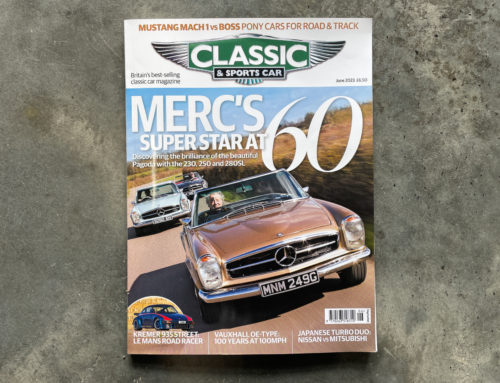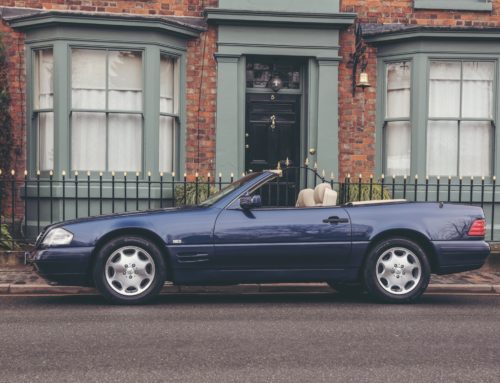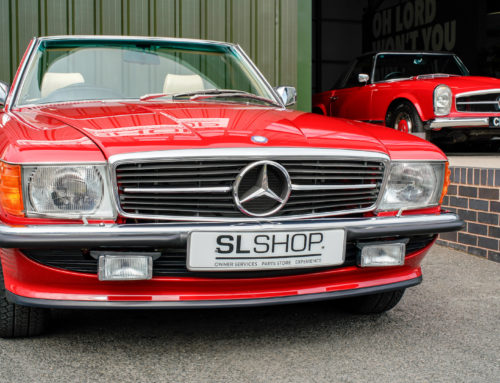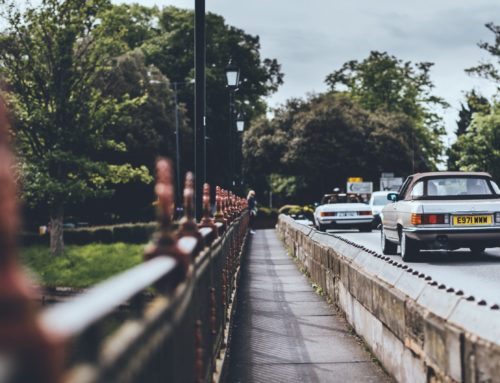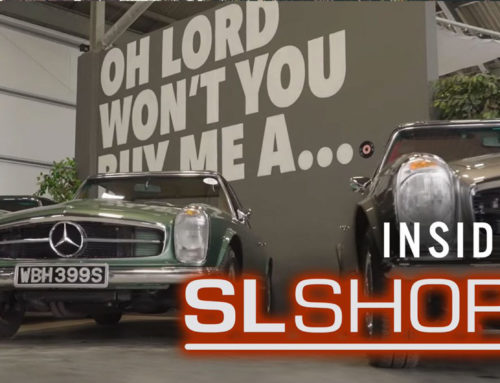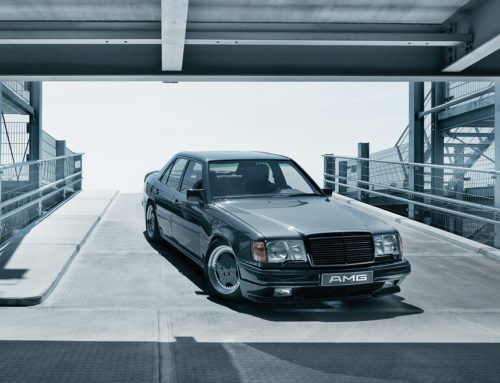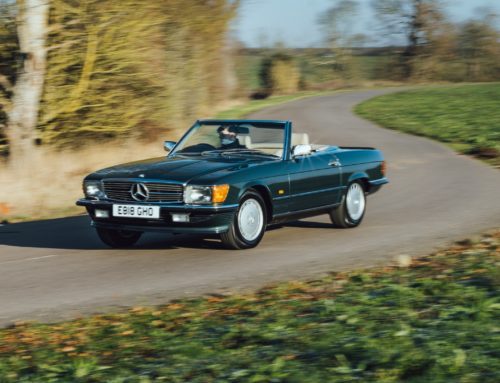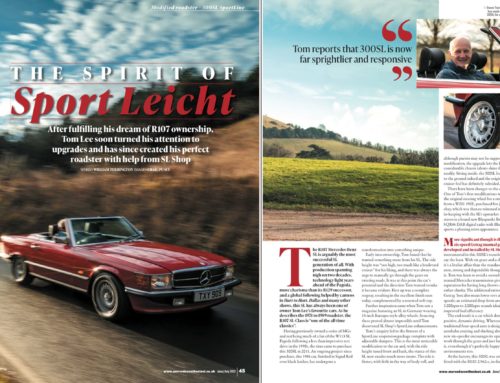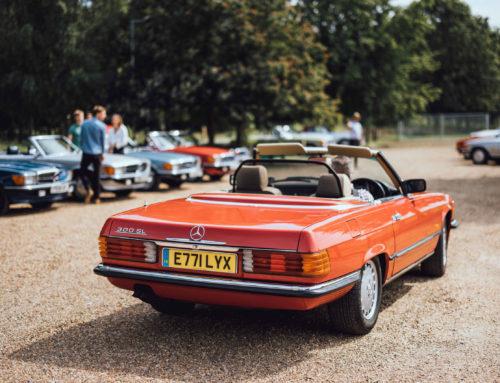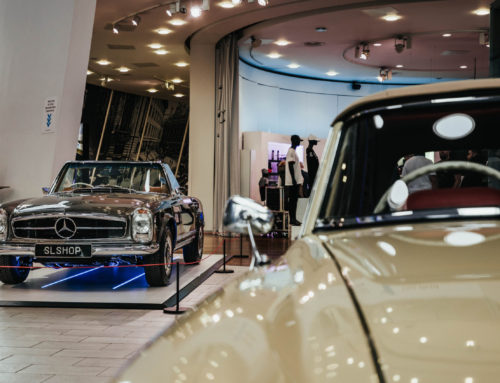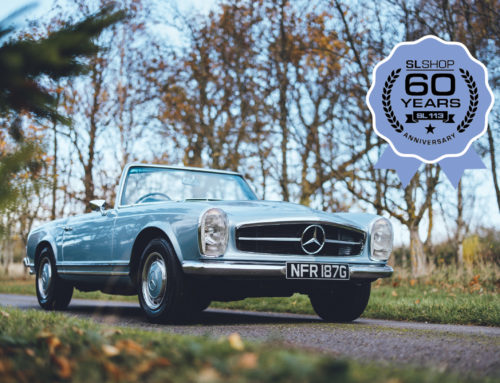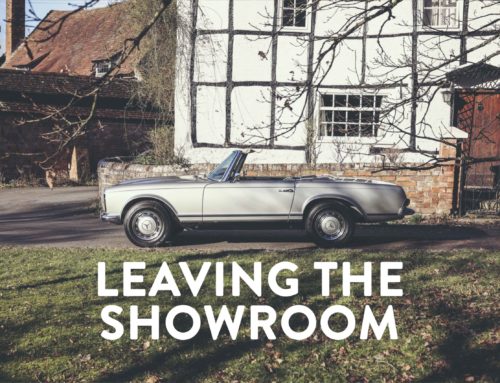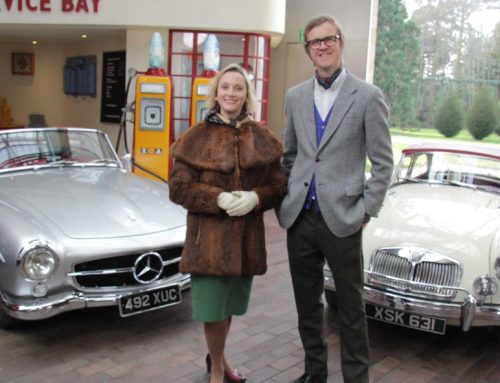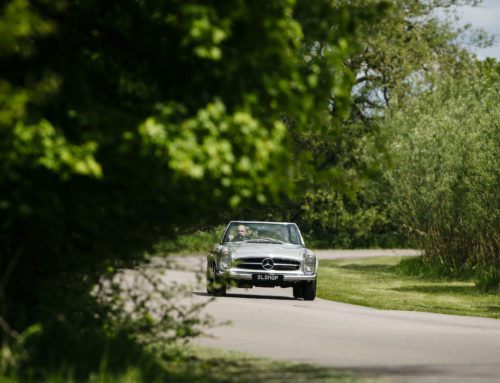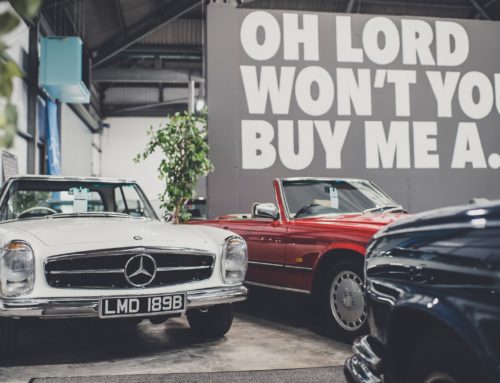The Post-War Choice
Launched as a prototype at the 1954 International Motor Sports Show alongside the 300SL ‘Gullwing’, the Mercedes-Benz 190SL quickly became a desirable mode of transport for the post-war baby boomers. With hourglass curves and a carefully calculated amount of classy chrome, the drop-top roadster would set Mercedes-Benz up for a successful lineage of convertible cars over the next 70 years.
As we write in 2022, finding a Mercedes 190SL in good order is becoming increasingly difficult, and with the ascension of online auction sites over the past 24 months, we advise you to be very cautious… Judge each car individually and don’t be swayed solely by imagery online. Go and inspect, touch, and smell the 190SL in person.
With these roadsters being over 60 years old now, bad examples are available in high quantities; so, finding one that you can immediately enjoy is going to be a more challenging task. We’ve put together several key things to be mindful of before and during the purchase journey. This is not a conventional buyers guide simply because the available 190SLs are all different – some have been restored, others are original and in need of repair. Assess each 190SL with caution.
What should you look for when buying a Mercedes 190SL?
Rust: Due to the 190SL’s double wall construction and lack of protective measures, the bodywork is particularly prone to rust; especially as there is a general lack of drainage holes across the whole platform. The few drainage holes there are, tend to get clogged quite easily.
Don’t be swayed by a glistening surface…
Where to check?
- Rocker Panel: You can expect to find rusty rocker panels, particularly at the stone guard end by the rear wheel. This a key structural section of the 190SL and will severely compromise structural rigidity, making occupants more vulnerable in the event of a collision.
- Chassis frame rails located beneath the door
- Mounting points for the rear chassis legs
- Boot: The boot floor and spare wheel well are extremely vulnerable due to the lack of drains and poorly executed seals around the boot lid and rear lights.
- Floor Panels: The driver’s side floor panel is particularly susceptible to rust. Cars that have stood for long periods will most likely have a leaking battery, which will seep straight down to the passenger’s side floor panel.
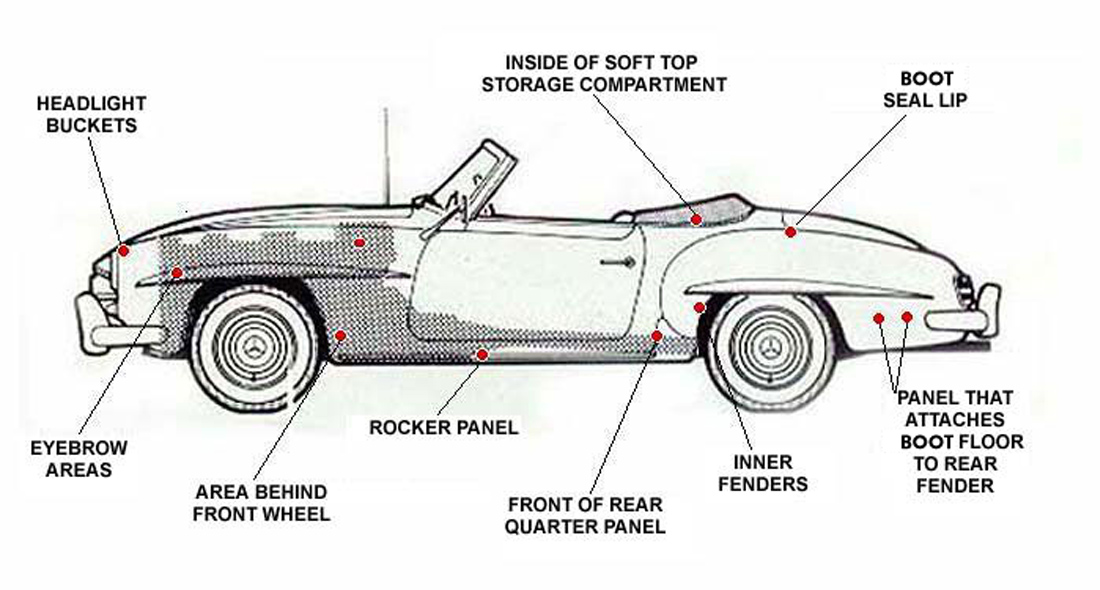
Has the 190 SL Mercedes been restored?
While the 190SL was mass-produced, each 190SL was essentially hand crafted according to the way each employee interpreted the production plans. This meant that each panel was prepared and constructed differently to the next 190SL. Chrome was also tailored to body panels, as were the dashboard and dashboard topper. This makes it very difficult to restore a car to the same standards and makes it quite expensive. Expect to find several ‘restored’ cars on the market that have been poorly executed.
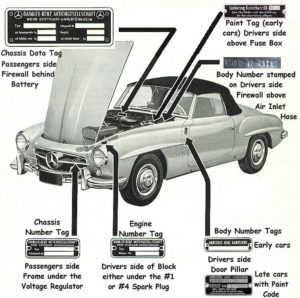 There are several ways to evaluate the claims that a car is completely original. Mercedes-Benz stamped the body, bonnet, doors, top bow and other areas with the vehicle identification number, allowing you to determine whether the body of the car itself is original. Similarly, MB stamped the front left side of the engine block just below the cylinder head gasket area with the same number, allowing you to tell if the engine is original to the vehicle.
There are several ways to evaluate the claims that a car is completely original. Mercedes-Benz stamped the body, bonnet, doors, top bow and other areas with the vehicle identification number, allowing you to determine whether the body of the car itself is original. Similarly, MB stamped the front left side of the engine block just below the cylinder head gasket area with the same number, allowing you to tell if the engine is original to the vehicle.
Other items that were stamped include the steering box, front left/right axles, the rear axle and transmission. The wheels were also stamped with dates which should match the production year of the vehicle outlined on your VIN number. We advise you to inspect all of these before making an investment.
Inside, soft items were also marked with a grease pencil with the same codes – you may find these on the seats and other soft items within the interior. Finding such markings is a good indication of an original interior.
Driving the Mercedes-Benz 190SL:
If you’re looking at a road-going example, make sure you are given the opportunity to drive the car. The key things to inspect are how it starts from cold, how does it idle and how does the engine respond to throttle inputs? Is the steering taught and is the ride smooth without any unwanted noises? Things to consider:
1. Improperly setup PHH44 Solex Carburettors:
We’ve decided to start with this topic as these are particularly notorious for having issues. Twin Solex Carburettors were fitted to the 190SL as a last resort due to the original provider falling short with their offer. It is suggested that the quick development of the PHH44 Carbs, led to a multitude of issues. The reliability of the PH44 has been the subject of debate for many years now; with some arguing that they are unreliable, while others believe there is a lack of knowledge around maintenance and setup.
Symptoms:
- Poor idling: When idling, you will notice fluctuations in output from the engine, with an inconsistent idle and almost ‘exhausted’ sound from the engine.
- Misfires: You may struggle to start the car and the engine may also lose power; with the likelihood of popping noises from the engine bay.
- Flat Power Spots: You may notice a hesitation at certain revs (1500-1900rpm).
Diagnosis:
- Knocked-out throttle valve shaft: Some specialists believe the shafts no longer rotate in the original centre when the bearings are repositioned, and they attempt to compensate for this by designing the throttle accordingly. This has not be known to cure the issue.
- Air leakage: This occurs at the air intake manifold due to incorrect fitment of the carburettor to the engine block. The carbs rest on rubber flange seals, with screws holes that contain bushes to maintain a certain distance between the carbs and intake manifold. If these are incorrectly set up, you will have an air leak.
- Out of Sync: It is likely that the two carbs are out of sync and so the mixture of air and fuel is not balanced, meaning the engine is not running efficiently.
- Engineering issues: The PH44 could have been developed too quickly and this resulted in the above flat power spots when driving.
The Cure:
Over the years, less craftsmen with the knowledge of these systems are available for support, resulting in the replacement of Solex with twin Webber carbs. For immediate remedy and worry of issues with your Solex carburettors, we strongly advise you consider this. The Webber replacements are also cheaper than a complete set of Solex carburettors so could help save costs where more vital work is needed elsewhere.
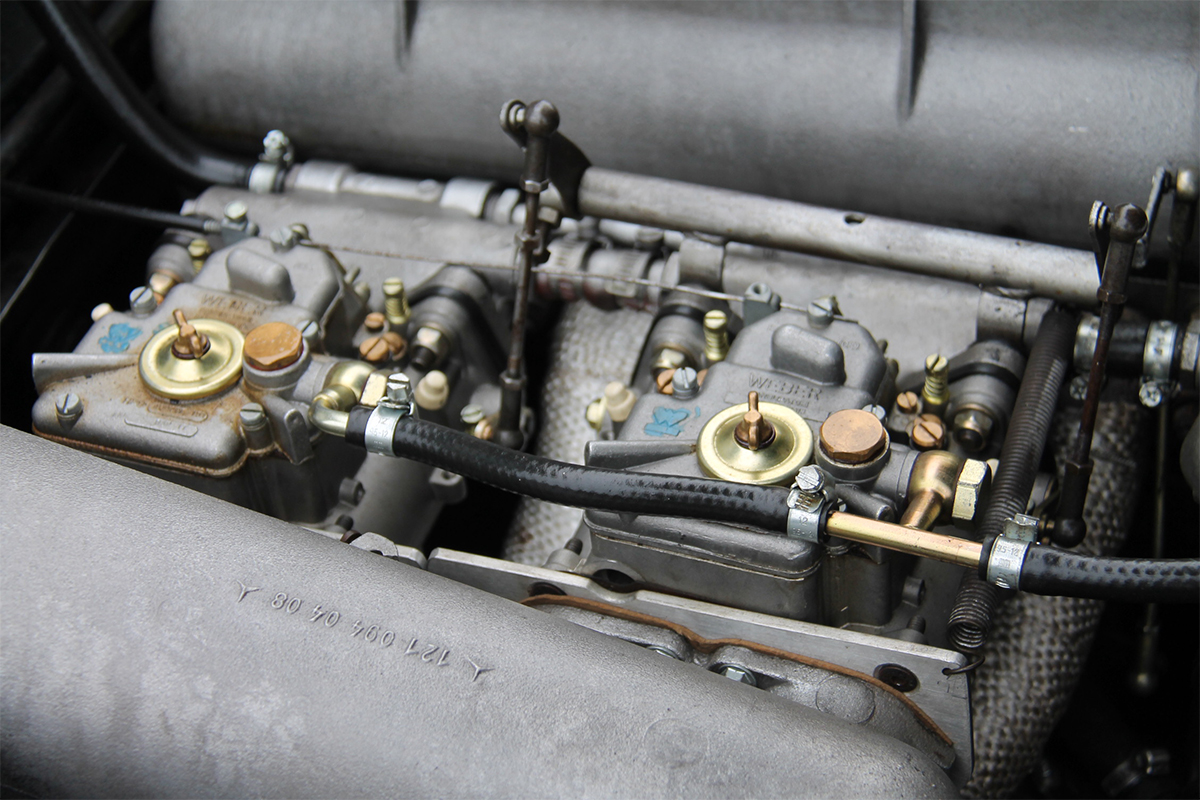
2. Rear Swing Axle:
As a cure to the feisty handling of the 300SL, MB gurus reengineered the swing axle setup from saloons of the era. Whilst this was an innovative measure, the bearings can wear out and cause a considerable amount of back lash.
Symptoms:
Differential ‘clunking’ sounds when you accelerate and decelerate.
Diagnosis:
- This could be due to the half-shaft and pinion seals leaking.
Cure:
We advise that you replace all these seals to overcome the issue.
3. E10: The floats found with Carburettors (particularly Solex) are extremely susceptible to the higher concentration of corrosive ethanol in E10. This type of unleaded petrol can cause several issues with the W121’s running efficiency, chiefly with vehicle’s stored over long periods with fuel in the tank.
Symptoms:
The effects of E10 can take time to materialise, but it can often cause poor running due to failed seals on mechanical fuel pumps, corrosion to rubber hoses and over longer periods, corrosion to the fuel tank. If your car is running poorly (lean), it can be difficult to tell due to the absence of a lambada sensor on the W121.
Cure:
Ideally, you should avoid E10 at all costs.
But, if you want to add some protection in preparation for using E10, have ethanol proofed rubber hoses fitted to your Mercedes 190SL. You should also consider swapping your Solex carburettors for genuine Webber ones with the brass float. Aftermarket Webbers have plastic floats which will not hold out against E10.
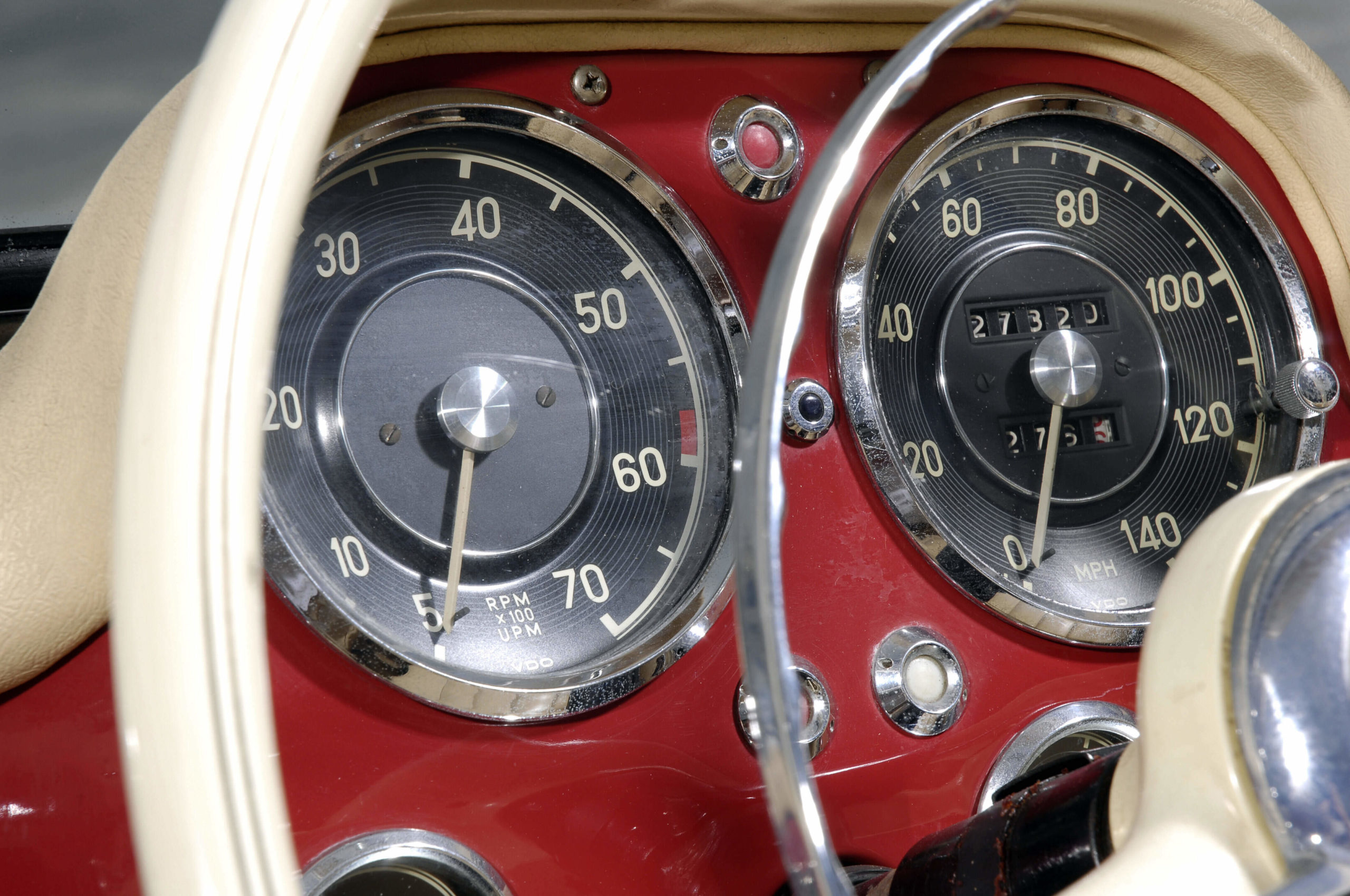
4. Vague Steering:
Symptoms: You may find that your steering inputs are having little to no effect. With the absence of power steering, the 190SL should be fairly direct when steering.
Diagnosis:
Steering joints gradually wear over time and become slack. Even a small amount of play or looseness in the joints can result in a very inaccurate and sloppy steering system.
Cure:
Replace all the steering joints and inspect all over elements of the steering system, including the tie rod and lower bushings. The steering seals are also important to replace as these become hard over time and allow oil to leak through and the bearings to wear.
5. Engine Mount Wear
Symptoms: When driving, you may notice excessive vibration through the steering wheel and generally within the cabin. This will be accompanied by rattles and subtle knocks at high speeds. In some severe cases, worn out engine mounts can cause the engine and intake manifold to touch the bulkhead.
Diagnosis:
- Aged Rubber: Made from rubber, the engine mounts will wear and crack over time.
- Fluid Leaks: Engine oil leaks can cause the rubber to soften and become ineffective
- Driving techniques: Over-revving the engine and improper use of the clutch will negatively effect your engine mounts.
- Accident Damage: If a 190SL has been damaged in an accident, you may be able to tell by looking at the engine mounts.
Cure: We recommend checking the engine mounts every five-seven years and replacing them where necessary – especially if there are signs of wear.
Super League Mercedes 190SL Support:
Due to the age and complexity of restoring these vehicles, we strongly advise you acquire a 190SL from a specialist who has checked for all of these issues outlined. Similarly, purchasing a Mercedes 190SL from a specialist like SLSHOP, ensures you are purchasing a car that has has work carried out prior to going on sale. All vehicles sold by SLSHOP are inspected and rectified before going on sale unless sold as a restoration project.
SLSHOP is the leading supplier of parts for the Mercedes 190SL, giving owners around the world access to Heritage Mercedes Parts, as well as high quality Reproduction Premium Mercedes Parts to enable you to revive and perfect your vehicle at home or with the help of a specialist garage. Wherever you are in the world, SLSHOP can support you with your goals.
Share With Your Fellow Enthusiasts
The Post-War Choice
Launched as a prototype at the 1954 International Motor Sports Show alongside the 300SL ‘Gullwing’, the Mercedes-Benz 190SL quickly became a desirable mode of transport for the post-war baby boomers. With hourglass curves and a carefully calculated amount of classy chrome, the drop-top roadster would set Mercedes-Benz up for a successful lineage of convertible cars over the next 70 years.
As we write in 2022, finding a Mercedes 190SL in good order is becoming increasingly difficult, and with the ascension of online auction sites over the past 24 months, we advise you to be very cautious… Judge each car individually and don’t be swayed solely by imagery online. Go and inspect, touch, and smell the 190SL in person.
With these roadsters being over 60 years old now, bad examples are available in high quantities; so, finding one that you can immediately enjoy is going to be a more challenging task. We’ve put together several key things to be mindful of before and during the purchase journey. This is not a conventional buyers guide simply because the available 190SLs are all different – some have been restored, others are original and in need of repair. Assess each 190SL with caution.
What should you look for when buying a Mercedes 190SL?
Rust: Due to the 190SL’s double wall construction and lack of protective measures, the bodywork is particularly prone to rust; especially as there is a general lack of drainage holes across the whole platform. The few drainage holes there are, tend to get clogged quite easily.
Don’t be swayed by a glistening surface…
Where to check?
- Rocker Panel: You can expect to find rusty rocker panels, particularly at the stone guard end by the rear wheel. This a key structural section of the 190SL and will severely compromise structural rigidity, making occupants more vulnerable in the event of a collision.
- Chassis frame rails located beneath the door
- Mounting points for the rear chassis legs
- Boot: The boot floor and spare wheel well are extremely vulnerable due to the lack of drains and poorly executed seals around the boot lid and rear lights.
- Floor Panels: The driver’s side floor panel is particularly susceptible to rust. Cars that have stood for long periods will most likely have a leaking battery, which will seep straight down to the passenger’s side floor panel.

Has the 190 SL Mercedes been restored?
While the 190SL was mass-produced, each 190SL was essentially hand crafted according to the way each employee interpreted the production plans. This meant that each panel was prepared and constructed differently to the next 190SL. Chrome was also tailored to body panels, as were the dashboard and dashboard topper. This makes it very difficult to restore a car to the same standards and makes it quite expensive. Expect to find several ‘restored’ cars on the market that have been poorly executed.
 There are several ways to evaluate the claims that a car is completely original. Mercedes-Benz stamped the body, bonnet, doors, top bow and other areas with the vehicle identification number, allowing you to determine whether the body of the car itself is original. Similarly, MB stamped the front left side of the engine block just below the cylinder head gasket area with the same number, allowing you to tell if the engine is original to the vehicle.
There are several ways to evaluate the claims that a car is completely original. Mercedes-Benz stamped the body, bonnet, doors, top bow and other areas with the vehicle identification number, allowing you to determine whether the body of the car itself is original. Similarly, MB stamped the front left side of the engine block just below the cylinder head gasket area with the same number, allowing you to tell if the engine is original to the vehicle.
Other items that were stamped include the steering box, front left/right axles, the rear axle and transmission. The wheels were also stamped with dates which should match the production year of the vehicle outlined on your VIN number. We advise you to inspect all of these before making an investment.
Inside, soft items were also marked with a grease pencil with the same codes – you may find these on the seats and other soft items within the interior. Finding such markings is a good indication of an original interior.
Driving the Mercedes-Benz 190SL:
If you’re looking at a road-going example, make sure you are given the opportunity to drive the car. The key things to inspect are how it starts from cold, how does it idle and how does the engine respond to throttle inputs? Is the steering taught and is the ride smooth without any unwanted noises? Things to consider:
1. Improperly setup PHH44 Solex Carburettors:
We’ve decided to start with this topic as these are particularly notorious for having issues. Twin Solex Carburettors were fitted to the 190SL as a last resort due to the original provider falling short with their offer. It is suggested that the quick development of the PHH44 Carbs, led to a multitude of issues. The reliability of the PH44 has been the subject of debate for many years now; with some arguing that they are unreliable, while others believe there is a lack of knowledge around maintenance and setup.
Symptoms:
- Poor idling: When idling, you will notice fluctuations in output from the engine, with an inconsistent idle and almost ‘exhausted’ sound from the engine.
- Misfires: You may struggle to start the car and the engine may also lose power; with the likelihood of popping noises from the engine bay.
- Flat Power Spots: You may notice a hesitation at certain revs (1500-1900rpm).
Diagnosis:
- Knocked-out throttle valve shaft: Some specialists believe the shafts no longer rotate in the original centre when the bearings are repositioned, and they attempt to compensate for this by designing the throttle accordingly. This has not be known to cure the issue.
- Air leakage: This occurs at the air intake manifold due to incorrect fitment of the carburettor to the engine block. The carbs rest on rubber flange seals, with screws holes that contain bushes to maintain a certain distance between the carbs and intake manifold. If these are incorrectly set up, you will have an air leak.
- Out of Sync: It is likely that the two carbs are out of sync and so the mixture of air and fuel is not balanced, meaning the engine is not running efficiently.
- Engineering issues: The PH44 could have been developed too quickly and this resulted in the above flat power spots when driving.
The Cure:
Over the years, less craftsmen with the knowledge of these systems are available for support, resulting in the replacement of Solex with twin Webber carbs. For immediate remedy and worry of issues with your Solex carburettors, we strongly advise you consider this. The Webber replacements are also cheaper than a complete set of Solex carburettors so could help save costs where more vital work is needed elsewhere.

2. Rear Swing Axle:
As a cure to the feisty handling of the 300SL, MB gurus reengineered the swing axle setup from saloons of the era. Whilst this was an innovative measure, the bearings can wear out and cause a considerable amount of back lash.
Symptoms:
Differential ‘clunking’ sounds when you accelerate and decelerate.
Diagnosis:
- This could be due to the half-shaft and pinion seals leaking.
Cure:
We advise that you replace all these seals to overcome the issue.
3. E10: The floats found with Carburettors (particularly Solex) are extremely susceptible to the higher concentration of corrosive ethanol in E10. This type of unleaded petrol can cause several issues with the W121’s running efficiency, chiefly with vehicle’s stored over long periods with fuel in the tank.
Symptoms:
The effects of E10 can take time to materialise, but it can often cause poor running due to failed seals on mechanical fuel pumps, corrosion to rubber hoses and over longer periods, corrosion to the fuel tank. If your car is running poorly (lean), it can be difficult to tell due to the absence of a lambada sensor on the W121.
Cure:
Ideally, you should avoid E10 at all costs.
But, if you want to add some protection in preparation for using E10, have ethanol proofed rubber hoses fitted to your Mercedes 190SL. You should also consider swapping your Solex carburettors for genuine Webber ones with the brass float. Aftermarket Webbers have plastic floats which will not hold out against E10.

4. Vague Steering:
Symptoms: You may find that your steering inputs are having little to no effect. With the absence of power steering, the 190SL should be fairly direct when steering.
Diagnosis:
Steering joints gradually wear over time and become slack. Even a small amount of play or looseness in the joints can result in a very inaccurate and sloppy steering system.
Cure:
Replace all the steering joints and inspect all over elements of the steering system, including the tie rod and lower bushings. The steering seals are also important to replace as these become hard over time and allow oil to leak through and the bearings to wear.
5. Engine Mount Wear
Symptoms: When driving, you may notice excessive vibration through the steering wheel and generally within the cabin. This will be accompanied by rattles and subtle knocks at high speeds. In some severe cases, worn out engine mounts can cause the engine and intake manifold to touch the bulkhead.
Diagnosis:
- Aged Rubber: Made from rubber, the engine mounts will wear and crack over time.
- Fluid Leaks: Engine oil leaks can cause the rubber to soften and become ineffective
- Driving techniques: Over-revving the engine and improper use of the clutch will negatively effect your engine mounts.
- Accident Damage: If a 190SL has been damaged in an accident, you may be able to tell by looking at the engine mounts.
Cure: We recommend checking the engine mounts every five-seven years and replacing them where necessary – especially if there are signs of wear.
Super League Mercedes 190SL Support:
Due to the age and complexity of restoring these vehicles, we strongly advise you acquire a 190SL from a specialist who has checked for all of these issues outlined. Similarly, purchasing a Mercedes 190SL from a specialist like SLSHOP, ensures you are purchasing a car that has has work carried out prior to going on sale. All vehicles sold by SLSHOP are inspected and rectified before going on sale unless sold as a restoration project.
SLSHOP is the leading supplier of parts for the Mercedes 190SL, giving owners around the world access to Heritage Mercedes Parts, as well as high quality Reproduction Premium Mercedes Parts to enable you to revive and perfect your vehicle at home or with the help of a specialist garage. Wherever you are in the world, SLSHOP can support you with your goals.
Share With Your Fellow Enthusiasts
More from Journal
CARE
THE ULTIMATE CERTIFIED SERVICING INVESTMENT PLAN
Your ownership journey matters to us, which is why we have created a simple certified servicing investment plan, tailored to your individual needs and aspirations.
Start investing today and our dedicated CARE team will work with you to increase the value and enjoyment you receive from your vehicle.

STAY IN TUNE WITH SLSHOP MOMENTS
As part of SLSHOP’s community of enthusiasts, you’ll be the first to hear about events and tours, key product offers, exciting stories from owners around the world and of course… our latest additions to the showroom. So, be the first to know and you might just sneak a car on your driveway or take your car’s condition to new heights with our exclusive replacement parts.
Or, visit SLSHOP Journal
